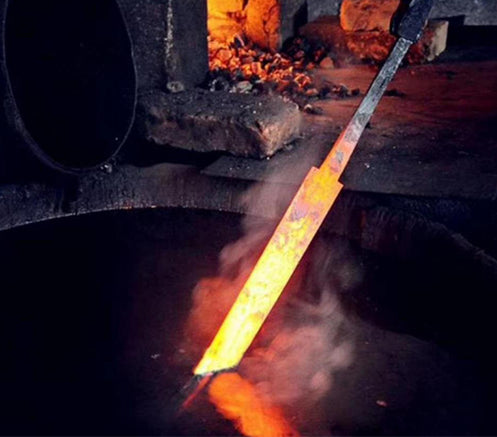Crafting Durable Blades: Annealing and Tempering
When it comes to crafting a machete blade that's not only sharp but also sturdy, the processes of annealing and tempering take center stage. These techniques, deeply rooted in metallurgy, ensure that your machete becomes a reliable companion in the toughest of tasks. Let's dive into the world of heat treatment and discover how machete blades are forged through annealing and tempering.
Annealing: Softening for Precision
Annealing is the process of heating the machete blade to a high temperature and then allowing it to cool slowly. Unlike tempering, where the aim is to achieve a specific hardness, the goal of annealing is to soften the metal. This process is typically performed before any significant shaping or machining of the blade.
Annealing helps to relieve internal stresses within the metal that might have built up during the forging or shaping process. By softening the metal, it becomes more malleable and easier to work with. This is crucial for achieving intricate designs or making adjustments to the blade's shape.
In the context of crafting machete blades, annealing is often performed before the final shaping and finishing touches are added. It allows the blade to be precision-crafted without the risk of cracks or structural issues.
Tempering: Forging Resilience
Tempering is a controlled heating and cooling process that follows the initial hardening of the machete blade. After the blade has been quenched to achieve maximum hardness, it's subjected to tempering to balance the blade's hardness and toughness.
During tempering, the machete blade is heated to a specific temperature and then slowly cooled. This controlled cooling eliminates some of the excessive hardness obtained during quenching, allowing the blade to become less brittle and more resilient. The exact tempering temperature varies based on the type of steel used and the desired characteristics of the blade.
The result of tempering is a machete blade with a well-balanced combination of hardness and toughness. This means the blade can withstand impacts and stress without fracturing, making it suitable for the demanding tasks machetes are often used for.
Crafting Blades That Endure
The combination of annealing and tempering is an art form that transforms raw steel into a machete blade that's both robust and versatile. Annealing provides the flexibility needed for intricate detailing and shaping without compromising structural integrity, while tempering enhances the blade's strength and toughness, ensuring it can tackle demanding tasks without failing.
Next time you hold a machete, remember that its strength is not just a product of the metal, but the result of carefully orchestrated processes that have been perfected over time. It's a testament to the fusion of science, skill, and a deep understanding of materials - all working in harmony to create a blade that's as functional as it is dependable.

